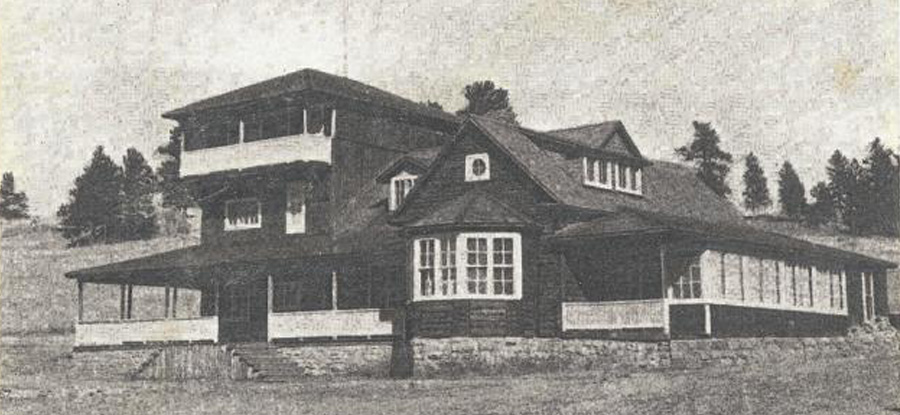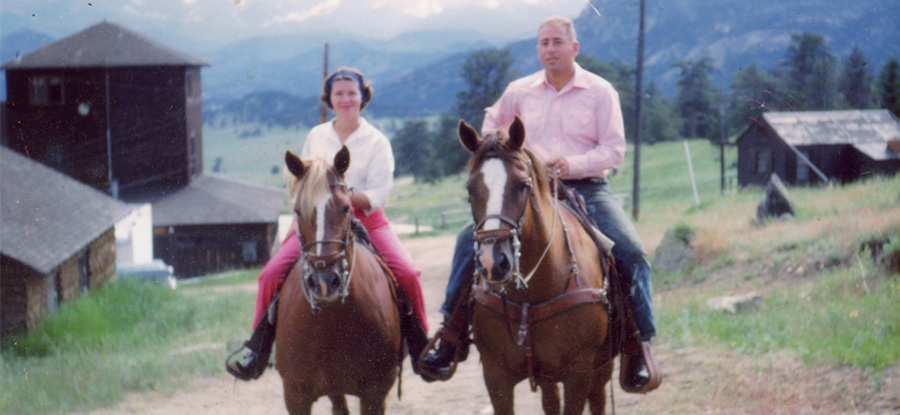Homesteading the land
Shep and Clara Husted from Missouri homesteaded this beautiful spot. Shep had previously traveled in the area, then went home to marry, loaded their belongings into several wagons and headed west. Their first winter as a married couple was spent in Denver, but the next year they began to homestead these grounds. A homestead is a tract of 160 acres, and to patent or prove it, one was required to be in residence for at least 6 months plus 1 day per year for 5 years. Shep and Clara Husted began homesteading and raising their children here in 1893.
Shep Husted was less than fully honest and over the years homesteaded about a square mile (640 acres) in this end of Estes Park using made-up names of relatives and what-have-you.
The hotel eras

Shep Husted hired an architect, Mr. W. C Rogers, to design the main lodge building and it was built and opened for business as "The Rustic Hotel" in 1901. It had many porches, some of which are now enclosed, like the office and the dining room. Shep Husted and his family ran "The Rustic Hotel" for several years with visitors from all over the world.
It seems that a disgruntled employee talked while in the wrong company stating that Shep Husted had homesteaded more than his allocated 160 acres. Legal action against Shep followed. Shep Husted's attorney, Mr. W. G. Edwards, saved him from going to jail as a result of a court trial but ended up owning "The Rustic Hotel." The property changed hands in July 1907 and Squire Edwards managed, as well as owned the hotel, until 1913.
At that time, Mr. Edwards sold the property to Mr. C. E. Lester for $13,000 and it then ran as the "Lester Hotel Co." until 1933.
New ventures as the H-Bar-G

In 1933, Mr. Julian Livingston bought the hotel as it was with furnishings, beddings, two team of horses and over 200 acres for under $15,000. Also, some of the now existing cabins were on the property and they were included in this and all transactions.
The Livingstons opened the place in 1934 as the H-Bar-G Ranch, a guest or dude ranch. Julian Livingston's sister, Helen Gates, was going to co-manage the operation with Shep Husted, the homesteader, hence they called the spread, H-Bar-G for Husted-Gates. At the last minute, Shep backed out and went to work for the Rocky Mountain National Park but the name H-Bar-G Ranch continues in use to this day.
Prior to 1934 there was no electricity at the Ranch so lighting was provided by acetylene that was piped throughout the property. In 1934 two generators were installed and private electricity was distributed to all the buildings at the Ranch. That mode of providing electricity lasted until about 1946 when the town of Estes Park began providing this service.
Also in 1934, the H-Bar-G Ranch vastly improved the water system, built four or five additional cabins, and installed bathtubs with coal-fired hot water in all cabins. It required two hired hands just to keep the coal stoves going all day.
Helen Gates continued to manage the H-Bar-G Ranch as a guest/dude ranch for 25 years until 1959.
In 1960 Mr. Julian Livingston then converted the H-Bar-G to a girls' horseback riding camp where campers each had their own horses.

In the spring of 1961, Mr. Julian Livingston passed away and his son, Mr. Lou Livingston and his wife, Anne, took over operations. Mrs. Anne Livingston continued to run the Ranch as a girls' riding camp until 1967.
Then the H-Bar-G Ranch was a Peace Corps Training Camp for 4 years and the Youth Conservation Corps Corps was here for about 2 years. From 1973 to 1999, Mr. Lou Livingston ran the H-Bar-G as a part of the International Youth Hostel Federation, once again welcoming guests from around the world.

After Lou's passing, the Ranch closed down public and commercial operations and has remained open to family and friends to enjoy the beauty of the northern Colorado mountains.

The cabins

Each of the cabins at the H-Bar-G Ranch have been named after some of the folks who had played some part in the history of the Ranch over the years.
- Homestead Built in 1893 by Shep and Clara Husted and used by them and their family for patenting or proving this land as their homestead.
- Shep's Place Completed in 1897 by Shep Husted, a good carpenter, after he and his wife Clara had two children and needed additional living room.
- Rogers Built prior to 1908 and named after Mr. W. C. Rogers, the architect who designed the main lodge/hotel building and several other local hotels.
- Edwards Built prior to 1908 and named after the attorney that defended Shep Husted and "won" ownership of the lodge/hotel building and ran it as the Rustic Hotel until 1913.
- Chapman The original portion was built prior to 1908 and named after Mr. Charles "Chappy" Chapman, probably one of the best carpenters Estes Park has ever seen.
- Lester The original portion was built prior to 1908 and named after Mr. C. E. Lester who owned and ran the hotel/lodge from 1913 to 1933. It was known as the Lester Hotel during that time period.
- Grampy Lou (formerly known as Adams) A government surplus building that was moved to the Ranch after World War Il and named after Mr. Don Adams who had a livery in Glen Haven, just over the hill. A genuine purebred character. In the early 2000's, the cabin was renamed after Lou Livingston, who, along with his wife Anne, had run the Ranch in various forms for nearly 40 years.
- Grampy John (formerly known as Squeaky Bob) A cabin that was moved three times before it landed at the H-Bar-G in 1923 and named after Bob "Squeaky" Wheeler, a tall man with a high-pitched voice that was a frequent visitor from over in the Bear Lake area. In the mid 2000's, the cabin was renamed after John Herrin, a New Hampshire native that spent many summers at the Ranch in a caretaker capacity.
- Hattan A government surplus building moved to the Ranch after World War Il and named after Mr. Everitt Hattan, an employee of the H-Bar-G from 1941 to the late 1980's.
- Clem Yore A "Hodgson House" prefabricated in Dover, Massachusetts and erected on the site after World War II. Mr. Yore was a character and famous writer, poet and journalist. He was an ex-editor of the Chicago Tribune and his books include: Dusty Dan of the West, The Legacy, and Young Desire.
- Dave Sterling A "Hodgson House" prefabricated in Dover, Massachusetts and erected on the Ranch after World War II. A locally renowned artist, Mr. Sterling was a painter who used to "throw" paint on canvas.
- Dunraven Named for the Earl of Dunraven, an Irish nobleman, who was an area personage and also sort of a scoundrel. He attempted to gain ownership of much of the land and maintain it as a private hunting preserve. He built the English Hotel in 1877 and claimed more than 6,000 acres. These claims were not relinquished until 1908.
- Tully Named for Mr. Fred Tully, a house painter that did all of the painting when the Livingstons purchased the Ranch. He painted anything that needed painting.
- Lindley Named for Mr. Bob Lindley, the Ranch's plumber. His claim to fame was teaching Maurice B. Rockwell, a fellow plumber, how to swear. Maurice learned from one of the best and was a good student too!
- The Bunkhouses Aptly named "Girls Dorm" and "Boys Dorm", the two bunkhouses housed many guests and staff members throughout the Ranch's time as a hostel, riding camp and dude ranch.
- Tim's Hut Named after one of Lou Livingston's sons-in-law, this winter retreat has allowed many great men and women alike the opportunity to ponder everything from future ranch projects, to that cool mountain air breeze, to that morning's cup of coffee, to life in general. Rustic design and décor.
